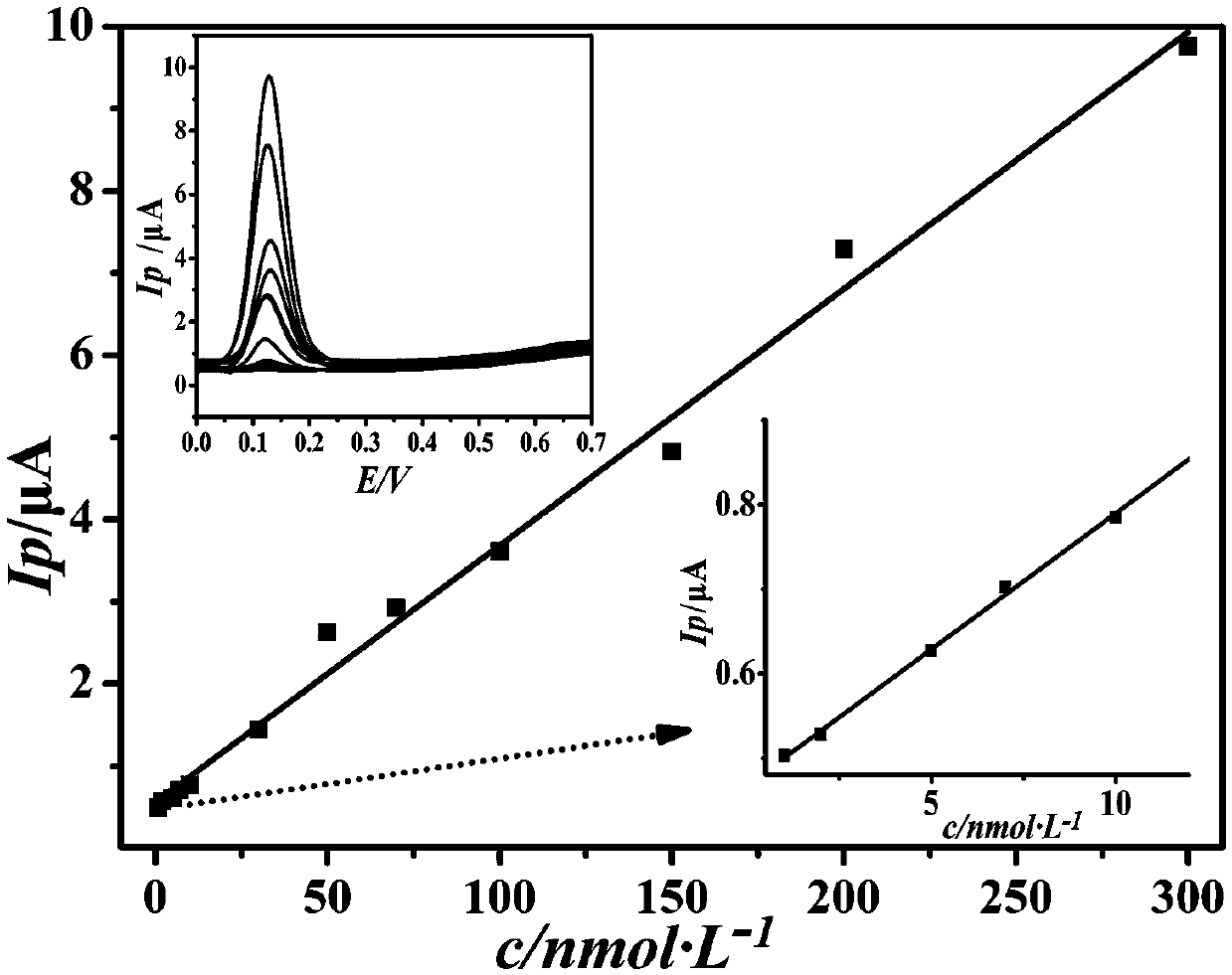Preparation method of composite sensitive film electrochemical sensor for detecting epinephrine
A technology of epinephrine and sensitive membrane, which is applied in the field of analytical chemistry and electrochemistry, which can solve the problems of narrow linear range, high detection limit, cumbersome operation, etc., and achieve the effect of enhancing detection sensitivity, excellent electrical conductivity, and enhanced electrical conductivity
- Summary
- Abstract
- Description
- Claims
- Application Information
AI Technical Summary
Problems solved by technology
Method used
Image
Examples
Embodiment 1
[0022] Preparation of composite sensitive membrane based on graphene: Take 10mL1.0mg·mL -1 Graphene oxide aqueous solution and 10mL1.0mg·mL -1 The acidic carbon nanotube suspension was uniformly mixed and ultrasonically treated for 2 h. Then, 20 mg of sodium borohydride was added, stirred vigorously for 5 min, and then heated to reflux at 130° C. for 3 h. The obtained product was centrifuged and washed with water, and dried at 30°C to obtain the product rGO / CNTs;
[0023] Take 5mg of titanium dioxide nanoparticles and evenly disperse them in 200mL of ultrapure water, sonicate for 10min, add 15mL of 0.1M sodium citrate, stir magnetically and slowly add 0.5mL of 0.1M hydroxylamine hydrochloride solution, then add 1.0mL of 1% chloroauric acid solution, stirred overnight, when the color of the solution turned orange, centrifuged and washed several times with water to obtain TiO 2 - Au nanoclusters;
[0024] Take 0.1grGO / CNTs and 10mgTiO 2 -Au nanoclusters were uniformly disper...
Embodiment 2
[0027] Preparation of composite sensitive membrane based on graphene: Take 20mL1.0mg·mL -1 Graphene oxide aqueous solution and 15mL1.0mg·mL -1 The acidic carbon nanotube suspension was uniformly mixed and ultrasonically treated for 2 h. Then, 30 mg of sodium borohydride was added, stirred vigorously for 5 min, and heated to reflux at 130° C. for 3 h. The obtained product was centrifuged and washed with water, and dried at 30°C to obtain the product rGO / CNTs;
[0028] Take 10mg of titanium dioxide nanoparticles and evenly disperse them in 150mL of ultrapure water, sonicate for 10min, add 20mL of 0.1M sodium citrate, stir magnetically and slowly add 1.0mL of 0.1M hydroxylamine hydrochloride solution, then add 2.0mL of 1% chloroauric acid solution, stirred overnight, when the color of the solution turned orange, centrifuged and washed several times with water to obtain TiO 2 - Au nanoclusters;
[0029] Take 0.15grGO / CNTs and 20mgTiO 2 -Au nanoclusters were uniformly dispersed...
Embodiment 3
[0032] Detection of epinephrine content in urine samples based on graphene composite sensitive membrane electrochemical sensor:
[0033] Modified electrode rGO / CNTs / TiO 2 -Au / GCE is the working electrode, the Ag / AgCl electrode is the reference electrode, and the platinum electrode is the counter electrode; within the potential range of 0.0-0.7V, differential pulse scanning is performed on the adrenaline standard solution samples with different concentrations, according to the peak current value and The relationship between the concentration of epinephrine, draw the working curve, the linear range is 1.0 ~ 300nM, the linear equation is ΔI p =0.5533+0.0313c, c is concentration, unit is nM, peak current I p The unit is μA, and the detection limit is 0.34nM;
[0034] Detection of epinephrine content in urine samples: modified electrode rGO / CNTs / TiO 2 -Au / GCE is the working electrode, the Ag / AgCl electrode is the reference electrode, and the platinum electrode is the counter elect...
PUM
 Login to View More
Login to View More Abstract
Description
Claims
Application Information
 Login to View More
Login to View More - R&D
- Intellectual Property
- Life Sciences
- Materials
- Tech Scout
- Unparalleled Data Quality
- Higher Quality Content
- 60% Fewer Hallucinations
Browse by: Latest US Patents, China's latest patents, Technical Efficacy Thesaurus, Application Domain, Technology Topic, Popular Technical Reports.
© 2025 PatSnap. All rights reserved.Legal|Privacy policy|Modern Slavery Act Transparency Statement|Sitemap|About US| Contact US: help@patsnap.com

